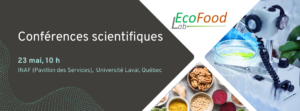Conférences scientifiques présentées par le EcoFoodLab
Un rendez-vous riche en découvertes!
Lien Zoom : https://ulaval.zoom.us/j/67605347980?pwd=dnQwRWtHSUJVd0VRY3FVbXFnNGNrUT09

L’INAF et le EcoFoodLab ont le plaisir de vous convier le 23 mai à des conférences portant sur l’alimentation durable.
Une activité qui vous permettra de découvrir plusieurs innovations scientifiques intéressantes et solutions d’avant-garde à des enjeux importants du secteur bioalimentaire.
Cet événement aura lieu en mode hybride.
Pour l’occasion, nous aurons l’honneur d’accueillir trois chercheurs de l’international.
Du German Institute of Food Technologies – DIL e.V en Allemagne :
Prof. Sergiy Smetana, Head of Food Data Group, German Institute of Food Technologies – DIL e.V.
Bio : Dr. Sergiy M. Smetana works as a Head of Food Data Group at the German Institute of Food Technologies (DIL e.V.) since 2017. However, he joined the institute in 2013 and was responsible for sustainability assessment of food and food technologies. Before that he worked as a Visiting Fulbright Scholar in Brook Byers Institute of Sustainable Systems (Georgia Institute of Technology, Atlanta, GA, USA) for a year and 6 years as a Leading Engineer in Institute of Nature Management and Environmental Problems (Ukraine). The focus of his research is sustainability assessment of innovative food processing technologies, alternative protein sources and data analysis of complex food systems.
Conférence : Development of alternative sustainable foods
Résumé : The modern food system is characterized with high environmental impact, which is in many cases associated with increased rates of animal production and overconsumption. The adoption of alternatives to meat proteins (insects, plants, mycoprotein, microalgae, cultured meat, etc.) might potentially influence the environmental impact and human health in a positive or negative way but could also trigger indirect impacts with higher consumption rates. The presentation will provide a condensed analysis on the progress of novel processing technologies, which can be applied for the development of new products their potential environmental impacts and resource consumption rates. Potential for the direct and indirect trade-offs associated with integration of alternative foods in complex global food system will be highlighted.
De la Pontificia Universidad Católica de Valparaíso au Chili :
Prof. Carolina Luisa Astudillo Castro, doyenne de la Faculté des Sciences Agronomiques et Alimentaires (voir la bio)
et Prof. Andrés Córdova (voir la bio)
Conférence : Current research of the Agrifood Bioengeering Group at the Faculty of Agriculture and Food Sciences PUCV
Résumé : The Food School of the PUCV, with more than sixty years of life, was one of the pioneers in the study of food systems in the country and joined the Faculty of Agronomy in May 2014 Subsequently, the Faculty was refounded with the denomination of Faculty of Agronomic Sciences and Food in August of the same year. As result of this merge, since 2017, the Faculty has a PhD. Program in Agrifood Sciences. The core objective is the development of research aimed at the scientific resolution of agro-industrial problems; leading to highly developed scientific capacities. This program has an academic character and it will also enable creation and development of new scientific and technological knowledge, applied to the sustainability of production systems and value-adding to agri-food systems and derived products.
Within this context, the Agrifood Bioengeering Group at the Faculty of Agriculture and Food Sciences – PUCV focuses its research in the study of food process intensification through bioprocesses and emerging technologies, and wellbeing through novel food alternatives. It is a small group leaded by 2 professors, and one technician, where 6 undergraduate students, and 2 PhD. students are developing their thesis. Currently, there are two main research projects founded by national research grants:
Novel Enzyme Membrane Bioreactors (MBR) for the synthesis of prebiotics oligosaccharides
Regarding the first one, Galacto-oligosaccharides (GOS) are powerful prebiotics which stand out for their ability to replicate the bifidogenic effect of human milk. Their synthesis has gained increased interest for their use in functional foods, but their industrial production is subjected to several challenges: i) their synthesis normally occurs with low yields (20% to 45%), ii) it is a kinetically controlled reaction, where pure lactose is the substrate, hence a mixture of hydrolysis products, (glucose and mainly galactose) strongly inhibits the enzyme, thus decreasing the reaction rate and iii) poor operational stability of some enzymes is still a drawback for its widespread industrial application. Industrial GOS production is conventionally performed with dissolved enzymes, involving several operational steps. Hence to increase the efficiency and productivity of synthesis is still required. The process intensification approach may be useful for improving the enzyme performance and reduce operation times, resulting in a more cost-effective process. In this regard, membrane bioreactors (MBR) have been tested in the last years, because they simultaneously combine mass transfer with chemical reactions, remove the inhibitory products from reaction site and provide a setup to house the biocatalysts. However, GOS yield is improved at very high substrate concentrations, increasing fouling appearance, limiting until now the application of MBR for long-term GOS production. Power ultrasound (US) is a green novel food technology in which substantial amounts of mechanical movements leads to the implosion of cavitation bubbles, generating high velocity interparticle collisions which improves mass transfer phenomena, enabling the application in membrane technology, avoiding fouling appearance. US has been also used in enzyme catalysis, improving the substrate access to the active site, thus increasing the reaction rate. Therefore, an interesting alternative of combining both technologies can emerge in what may call MBR assisted by ultrasound (MBR-US). Other recent alternative is the development of membrane bioreactors with magnetic nanoparticle bioconjugates (MBR-MNB). In this technology, a reversible magnetic force facilitates dispersion of enzymatically active magnetic nanoparticles, providing a suitable water microenvironment to the enzyme and its proper distribution, limiting the effect of molecular crowding. This system also allows full enzyme recovery and also avoids fouling because the substrate does not directly interact with the membrane. These two strategies are currently in an incipient state of development in our laboratory, but we have just finished a preliminary stage where native whey obtained during casein micelle microfiltration was used as a novel source to produce galacto-oligosaccharides (GOS). Since the presence of macromolecules and other interferers reduces biocatalyst performance, this work evaluated the effect of different ultrasound processing conditions on GOS synthesis using concentrated native whey. For instance, at 40 °C, 40% w/w native whey, 70% wave amplitude, and 0.6 s/s duty, a UI of 30 W/cm2 was achieved, and the increased specific enzyme productivity was similar to the values obtained with pure lactose (~ 0.136 g GOS/h/mgE). This strategy allows for obtaining a product containing prebiotics with the healthy and functional properties of whey proteins, avoiding the required purification steps used in the production of food-grade lactose.
Hydrocolloid based edible coatings as strategy to produce healthier French fries options
Other research topic performed by one PhD. student is the “Development of a functional snack through an intensified impregnation and dehydration process using hydro-conductive vacuum drying: from design to bioaccessibility”. Here the objective is to develop a functional snack food through the combination of vacuum impregnation, CO2 laser microperforations and ultrasound using a drying process based on vacuum refractance window (VRW), thanks to the incorporation of lutein, synbiotics, and native collagen inside this food matrix. Within the scope of this research, an in-vitro digestion and bioaccessibility of the impregned dried material is also considered to assess the effectiveness of these compounds on the delivery of wellbeing properties.
Regarding to the second project, French fries are very popular. However, i) potatoes are rich in digestible carbohydrates, having a high glycemic index (GI) due to their high amount of easily digested starch; ii) frying involves heat and mass transport phenomena leading to oil uptake (OU) inside the product, resulting in increased lipid and caloric content, and iii) potato frying naturally leads to Maillard reaction resulting in the formation of acrylamide. Recently, the application of hydrocolloid-based edible coatings (HBEC) such as alginate, xanthan gum, cellulose derivatives, and others have shown to be effective in reducing OU and mitigating acrylamide production in French fries manufacturing. On the other hand, exits some evidence than pectic polysaccharides reduce the absorption of digestible carbohydrates in fried potatoes by the reduction of α-amylase activity, modulating the gastric movements, increasing the activity of the micro gut, increasing satiety, and reducing GI. The main goal of this proposal was to develop an ingredient based on HBEC to be applied as a coating on French fries and assess its effectiveness on the reduction of the glycemic index, oil uptake and acrylamide formation during the processing of French fries trough and the impact on the glycemia, insulin response and satiety after consumption using in vitro and in vivo studies.
Our closer national partnerships are the School of Nutrition at Universidad de Valparaíso, the Department of Chemical Engineering and Environment Sciences at Universidad Técnica Federico Santa María, The Metropolitan Technology University UTEM, The Regional Center for Healthy Foods CREAS, while internationally we still collaborate with the Institute of Membrane Technology ITM-CNR, Italy, the Department of Food Science at Ohio State University, USA, the Department of Food Engineering at Universidad de Cartagena, Colombia, and with the Civil and Environmental Engineering, College of Engineering at the University of Rhode Island, USA.
